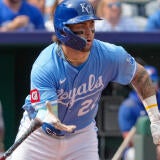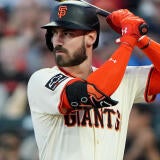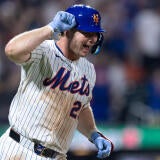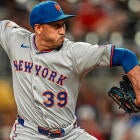Early Fantasy Baseball Sleepers for 2026: Find ADP value before the hype takes off
Chris Towers helps you cash in before ADP skyrockets on these Fantasy studs

People are drafting Fantasy Baseball teams right now. As we speak. You might recoil in horror at such things, knowing we have an entire offseason's worth of signings, trades, and injuries that will inevitably render countless picks made in November totally worthless.
That's the pessimist's argument against drafting right now. Here's the optimist's: You can draft Konnor Griffin, Kevin McGonigle, and JJ Wetherholt maybe 100 picks or more later than they'll eventually cost this spring, once it becomes clear they are going to make the Opening Day roster. There are other arbitrage opportunities to be found in these early drafts – specifically around current free agents, who almost always have a depressed price this time of year, as if … they may never sign at all? – but the biggest one is you get a chance to draft next spring's most hyped names at a price that actually makes sense.
Which is to say: Right now, those three guys should all qualify as "sleepers" for 2026 right now, and I don't think you'll be able to make that case by the time most of you are drafting. Once Spring Training ramps up and it becomes clear these guys are going to make the roster, we're going to see their prices skyrocket, and for me at least, the term "sleeper" always comes down to price. I don't have a hard and fast definition of it right now, with how much prices are likely to change between now and the spring, but I think "after pick 250 in ADP" is generally a pretty good starting point, and all three qualify based on those early drafts.
So do the following players, and I feel pretty confident none of these 10 are likely to see their prices rise enough to where they won't qualify. I'll revisit these picks a little closer to the start of Draft Prep season, but for now, here's my initial list of 10 of my favorite sleepers for 2026.
Before we get to that, don't forget to check out (and bookmark!) our Offseason Tracker, where Scott White and I are breaking down every single Fantasy-relevant move that goes down, including the Brandon Nimmo-for-Marcus Semien trade from this weekend:
Way-Too-Early 2026 Sleepers
And we'll start with one of the top free agents on the market ...
Tatsuya Imai, SP, Free Agent
I had a general rule of trying to stick to players outside of the top-250 in early ADP, and Imai is close enough (around 240) that I want to include him here before the hype really goes off the rails. Because I think that's likely to happen once Imai signs for what figures to be a pretty gigantic sum of money. Probably not a Yoshinobu Yamamoto-sized sum of money, because Imai isn't a Yamamoto-level talent – Yamamoto was a five-time All-Star, three-time MVP, three-time Triple Crown winner, and three-time winner of the Japanese equivalent of the Cy Young award, while Imai is a three-time All-Star … and that's about the extent of the superlatives.
Of course, there's nothing wrong with not being Yamamoto, who was arguably the most decorated Japanese pitcher to ever make it to MLB and who signed one of the biggest free agent contracts in MLB history. Imai is probably ahead of the likes of Kodai Senga and Shota Imanaga, at least in part because he's a few years younger than either when they came stateside. The scouting reports are pretty impressive, with Lance Brozdowski noting that Imai may be the best starting pitcher in this free agency class thanks to a good fastball, excellent splitter, and unique slider that should all play.
Is Imai likely to be a superstar? Maybe not, though, The Athletics' Eno Sarris has comped him to Joe Ryan, which is a pretty nice name to be attached to. How Imai adapts to the slightly larger and less tacky baseball used in MLB is an unknown, but seeing Imanaga, Senga, and Yamamoto succeed in that transition in recent years should assuage some of your doubts. This is a very talented pitcher in the prime of his career, and his price isn't too expensive … yet. When he signs, I could see that price skyrocketing closer to 100, which will be tougher to swallow. If and when that happens, we can reconsider, but for now, he qualifies here.
Francisco Alvarez, C, Mets
Alvarez might have figured it out in 2025. It took a trip back to Triple-A to rework his swing, but by the time he returned to the majors in late July, he looked like a totally different hitter, going .276/.360/.561 with eight homers in his final 139 plate appearances. It came with an improved strikeout rate, though one that didn't quite stick as he worked through some injuries in the second half and saw his rate jump back to 28% in September. But the power was there all along, with his expected wOBA jumping from .300 before his demotion to .351 after his return. Given the newfound depth of the catcher position, Alvarez's breakout might end up lost in the shuffle, especially since it was interrupted by an IL trip. That's okay, because that just means his price should remain very reasonable for a guy who will absolutely be a priority No. 2 catcher target for me.
Bryce Eldridge, DH, Giants
Entering the season, Eldridge was neck and neck with Nick Kurtz on the prospect rankings. On FanGraphs' top 100, Kurtz was No. 25, and Eldridge was 26; on Baseball Prospectus' Top 101, Kurtz was No. 33, and Eldridge was 15; our own Scott White had Kurtz 20th and Eldridge 28th. Now, I'm not arguing Edridge is or will be as good as Kurtz – I think it would be foolish to make that claim after the rookie season Kurtz just had. I'm just saying, we're not that far removed from Eldridge being viewed more or less the same as a guy who is now a consensus second-round pick in Fantasy.
But it's to say that Eldridge should be viewed as a potential impact bat, and nothing we saw in his 10-game cup of coffee at the end of the season should change that, especially since he was apparently playing through a wrist issue that ultimately required surgery in the offseason. He hit .260/.333/.510 with 25 homers in 102 games across his minor-league season, and I bet if he hadn't made it to the majors at the very end of the season and struggled, he'd have much more hype in Fantasy circles. Instead, he's sitting on a 464.9 ADP in early drafts. His UTIL/DH-only status hurts there, but he should play first base regularly enough to gain eligibility fairly early on, so I'm not really discounting that. This is your chance to get a very hyped young power prospect at a discount. Don't miss it.
Kristian Campbell, 2B, Red Sox
Campbell's coronation didn't exactly go as planned. After emerging as one of the top prospects in baseball in 2024, he cracked the Red Sox's Opening Day lineup, but we eventually sent down after hitting .223/.319/.345 in 67 MLB games before being sent down. He fared better in his first extended look at Triple-A, but didn't exactly hit like a future start – his .273/.382/.417 line featured solid on-base skills but surprisingly little power. Maybe Campbell's 2024 breakout was a fluke – his 84 mph average exit velocity at Triple-A is especially concerning when combined with a 26% strikeout rate – but I'm willing to take a discount on a guy the Red Sox liked enough to give a $60 million extension just over seven months ago. As tough as this season was for Campbell, I'll always take the opportunity to bet on a player this talented at a discount.
Jordan Lawlar, 3B, Diamondbacks
A lot of what I said for Campbell applies for Lawlar, who just hasn't quite figured out the next steps in his development yet. Because he made his debut back in 2023, it's fair to have some fatigue about Lawlar, who has hit just .165/.241/.237 in his time in the majors. But here's the thing: Despite how long it feels like he's been around, Lawlar only turned 23 years old four months ago and has just 108 plate appearances in the majors right now. He's about four months younger than Jacob Wilson and Colson Montgomery; he's more than a year younger than Jakob Marsee. And, for as disappointing as he has been in the majors, Lawlar just had a 130 wRC+ at Triple-A while being the youngest player on his team. There's pop and speed here, and while I have some concerns about the contact skills translating, the rest of the skill set is impressive enough that I remain willing to bet on Lawlar figuring it out eventually.
Otto Lopez, SS, Marlins
For a lot of these sleepers, we're focusing on guys with perceived or potential superstar upside, but that isn't Lopez. I suppose you could squint and maybe see a Geraldo Perdomo-esque breakout here, but that's exceedingly unlikely – just as it was exceedingly unlikely for Perdomo, of course. In Lopez's case, this is more about identifying a player with a solid floor – he had 15 homers and 15 steals last season! – with the potential to build a nice little house on top of it. You might read the past few seasons for Lopez as him having to trade batting average for power, hence his drop from a .270 average to .246 while his homers jumped from six to 15. But in reality, Lopez's contact skills actually improved in 2025, as he continued to make plenty of contact while making even better swing decisions than before, and he did that while maintaining his quality of contact. Lopez's expected batting average was .271, and while the power and speed would still be pretty marginal even if he hit .271, you don't have to project much growth at all to push him closer to 20 in each category. Again, it's unlikely to ever manifest as star-level production, but Lopez should be a viable middle infielder in 2026, with room to be even more than that.
Justin Crawford, OF, Phillies
It's easy, and perhaps a little lazy, to just point to Crawford's father, Carl, and say that's who Justin is, but let's take a look at what both managed to do at Double-A and Triple-A in their careers (paced to 150 games):
- Carl Crawford: .290 average, 8.1 HR, 44.1 SB, 5.8% walk rate, 16% strikeout rate
- Justin Crawford: .333 average, 10.0 HR, 61 SB, 10% walk rate, 17.5% strikeout rate
You should not take this to mean that Justin Crawford is a better player or prospect than his famous dad was, of course – the elder Crawford was at least a couple of years younger at every level and ended up making his MLB debut almost exactly one year younger than Crawford is right now. That matters.
It also matters that Crawford the Younger is a controversial prospect. He's a premium athlete who hits the ball hard but almost never hits it in a way that is likely to create real damage, and his outlier BABIPs (.407 at Triple-A in 2025!) likely won't survive the transition to major-league defenses intact.
But he seems all but assured a spot on the Phillies Opening Day lineup card and should at least be a plus contributor in batting average and stolen bases while playing every day. And if he can tap into the above-average raw power by elevating the ball more consistently, there's a fairly high ceiling here. And the floor might just be something like Nico Hoerner.
Cam Smith, OF, Astros
If Smith had spent most of his age-22 season crushing it in the minors, our expectations would probably be higher than they are after seeing him merely hold his own in the majors with just 32 professional games under his belt. This is one of those things that happens with young players who make it to the big leagues on an accelerated timetable like this – they end up punished in the eyes of Fantasy players for no longer having the mystery box element of being prospects.
There wasn't a ton to point to from Smith's time in the majors to be optimistic about, to be clear. He showcased some interesting physical skills – 95th percentile sprint speed, 84th percentile bat speed, 89th percentile max exit velocity – but didn't look close to being ready to put them into play consistently enough for us to really care. And maybe that's just who he is: A talented young player, but not one with the real baseball skills to take advantage of it. I'm open to that possibility, but given his lack of experience against high-level competition, I'm also willing to give him the benefit of the doubt that the impressive physical tools will end up mattering in the long run. With a current ADP outside of the top 300, that's a bet worth considering.
Troy Melton, SP, Tigers
Melton represents another chance to get in on the ground floor of a player I expect to be much more expensive than he currently is by the time the spring rolls around. The soon-to-be 25-year-old more than held his own in his time in the majors last season and seems likely to have a spot in the Tigers rotation regardless of what they opt to do with Tarik Skubal. His 20% strikeout rate while pitching primarily in relief may not blow you away, but the various Stuff+ metrics suggest there should be more upside here than he showed in his first taste of the majors, and the Tigers' recent success with pitchers like Tarik Skubal and Casey Mize makes this a good spot to bet on a step forward.
Parker Messick, SP, Guardians
Messick didn't come to the majors with the hype of some of the other rookie pitchers, and while he was very successful (2.72 ERA over 39.2 innings of work), he didn't quite reach the heights of Nolan McLean, Cam Schlittler, or Trey Yesavage. And it's fair to say he probably doesn't have the upside any of those guys have, with velocity that is more around average, even for a lefty. And you'll see it in the Stuff+ models, which think he has below-average stuff. But there's two things to keep in mind here: One is that Stuff+ models still seem to struggle capturing what makes changeups effective, which is going to be a problem with a pitcher like Messick, whose biggest strength is a changeup that generates plenty of whiffs and awkward, weak swings.
And there's also this: While the stuff might not be great, the command was, with only five qualified pitchers posting a better Location+ score than Messick's. His was in a much smaller sample size, so some skepticism is not unwarranted. But he looks a lot like Matthew Boyd right now, in an organization with a reputation for maximizing what they get out of starting pitchers. He probably doesn't have the super high-end outcomes some of the other young pitchers have, but he's a relatively finished product with three seasons in a row of 120-plus innings, making him as safe a bet for health as any young pitcher can be. Our late-round picks tend to prioritize upside over everything, but Messick's combination of solid skills and safety makes him a nice pivot for your staff.

















